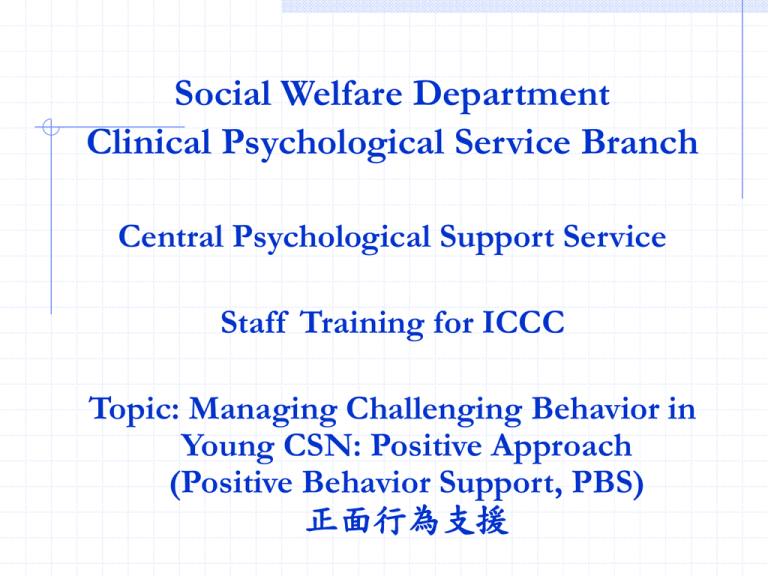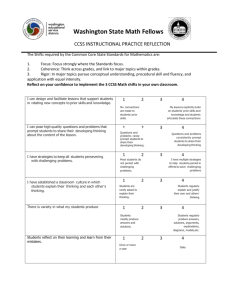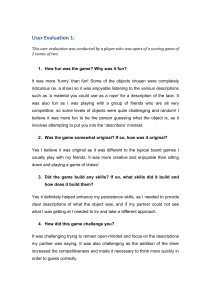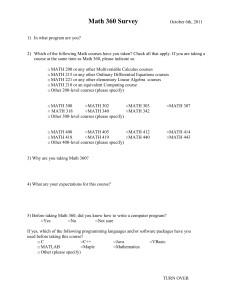Managing Challenging Behavior in Young Children: A Positive
advertisement

Social Welfare Department Clinical Psychological Service Branch Central Psychological Support Service Staff Training for ICCC Topic: Managing Challenging Behavior in Young CSN: Positive Approach (Positive Behavior Support, PBS) 正面行為支援 Presentation Outline Introduction Functional Assessment (功能評估) Interventions: Environmental Arrangement Interventions that Honor the Function of the Behavior Interventions that Do Not Honor the Function of the Behavior Challenging Behavior “Behavior emitted by a learner that results in self-injury or injury to others, causes damage to the physical environment, interferes with the acquisition of a new skill, and/ or socially isolates the learner” Doss & Reichle (1991) Forms of Challenging Behavior Aggressions Tantrums Self-injuries Hitting Scratching Kicking Biting Pinching Throwing objects Crying Screaming Whining Scratching Biting Pinching Self-choking Eye-gouging Intervention Strategies REACTIVE ANTECEDENT Intervention consequences implemented after behavior has been produced Intervention implemented prior to emission of challenging behavior in situations associated with challenging behavior Traditional Reactive Strategies Reinforcing Alternative Behaviors Differential Reinforcement of Low Rate Extinction Timeout Response Cost Over-correction Satiation Punishment Antecedent Strategies Why Are They Advantageous? More effective than strategies that simply serve to control or suppress behavior Opportunities can be generated Less disruptive to the environment than reactive procedures Educative: new skills may be acquired in the absence of frazzle(tedious and tiresome effort) Opportunities to interrupt chain of stimuli associated with challenging behavior Do not have to deal with the behavior Functional Assessment Functional Assessment a process of determining the relationship between events in a person's environment and the occurrence of challenging behaviors. assumes that individuals with disabilities behave in adaptive ways to ongoing changes in their environment (except those habitual behaviors that do not have obvious functions or symptoms of particular disorder) Main Outcome of a Functional Assessment A description of the challenging behavior An identified social function or purpose of the behavior Identified setting event(s) associated with the behavior Case 1 Behavior Mary hits other children during gross motor time when she does not get her way Functional Analysis Get tangibles Setting Event Inadequate sleep, sickness Other factors Limited verbal expression skills Lack of structure and rules in the gross motor area Overcrowding in the gross motor area Case 1 Behavior Intervention Plan Teaching appropriate behavior to get what she wants Provide support and cues to use appropriate behavior Praising appropriate behavior Structure the GM area to eliminate the possibility of engaging in the challenging behavior Involved speech therapist to teach him specific phrase and sentence to express herself in the setting Discuss with parents about sleeping pattern to ensure adequate sleep and develop good habit Pay more attention to child when she is sick Case 2 Behavior Tom makes irrelevant and inappropriate comments during story time Functional Analysis Get attention Setting Event Usually on Monday Sit at the back Other factors Child has told teacher that his mother has favoritism towards his younger brother The format of the story time allow limited student participation Case 2 Behavior Intervention Plan Increase student participation in story time and require student to raise up hand before speaking Give him chance to do classroom duty and praise prosocial behavior Discuss with parents about sibling rivalry issue Expand interest that he can engage himself Teach him techniques to control himself and provide reinforcement Seating arrangement to minimize opportunity to talk at the back Case 3 Behavior David throws temper tantrum when he is doing his class-work in writing Functional Analysis Avoid task Setting Event Reprimand by parents the day before on homework in writing Teasing by peer about his poor writing Other factors Child has fine motor skills problem Parents are strict in demand of his writing skills Child easily felt anxious and is sensitive to comment Case 3 Behavior Intervention Plan Recognize the physical signs that he is becoming anger. Arrange quiet corner when he is distressed Teach him relaxation skills Practice communication skills of requesting for a break and assistance Discuss with parents about parenting issues Peer mediating strategies – buddy program Seeking support from professional Curricular and environmental modification to facilitate him learning in proper pace Functional Assessment Methods Indirect Assessments Direct Observation Strategies Environmental Manipulation Assessments Indirect Assessment (Appendix C,D & E) Indirect Assessment What exactly does the behavior look like? What do you think is the possible motivation/ function for behavior? What events/ situations predict the behavior? What does the child like and not like? How does the child communicate wants and refusal? What are some other factors (medical, outside school schedule) that may affect behavior? Indirect Assessment Setting Events Conditions that occur concurrent with problem behaviors or are more distant in time and increase the probability that challenging behavior will occur. Indirect Assessment Setting Events Staff changes Medications were changed Slept fewer/ more hours than usual Show signs of illness Chaotic/ Demand situations Surprise visits from people Unexpected things occur Experienced a long waiting time Temperature of environment was too hot/cold Unpleasant environment (physical/ social) Reprimand by caregiver Was aggressed upon by another peer Direct Observation Strategies (Appendix A & B) Direct Observation Strategies – ABC Charts Antecedent (前因) Behavior (行為) Consequence (結果) Functional Analysis (Appendix F & G) Function of Challenging Behavior Obtain Desirable Events Attention Tangible/ Sensory Avoid/ Escape Undesirable Events Attention Tasks/ Change/ Sensory Environmental Manipulation Assessments What are they? Controlled comparisons of at least two different antecedents or two different consequences that are hypothesized to influence the emission of challenging behavior Why should they be implemented? To clearly identify specific antecedents and/or consequences influencing challenging behavior that could not be isolated during direct observation Behavior Intervention Plan (Appendix H & I) Interventions: Environmental Arrangement Environment Arrangement Goal: safe, easy-to-use, promoting desired behavior and preventing problems Key Ingredients for Structuring Your Program for Positive Behavior Create a physical arrangement that eases management, promotes interaction, and prevents problems. Establish program rules that help guide behavior of children and adults. Utilize staff in an efficient and effective manner. Provide materials that promote attention and persistence. Develop a daily schedule that establishes transitions and routines. Tips for Arranging Activity Areas Activity areas - distinct areas, separated by low dividers that the teacher can easily see over Separate areas by using low barriers, tape on floor, carpet, tables, shelving, room dividers. Label activity areas (e.g., a picture of children playing with blocks with the word BLOCKS). Activity areas should be arranged so that quiet activities are together (e.g., art, reading, and listening to tapes). Tips for Arranging Activity Areas Louder activity areas should be together (e.g., blocks, dramatic play) Separate quiet & active areas (e.g., cars & reading) Check traffic patterns between activity areas, bathrooms, etc. Are they planned so that children can easily move from one area to another? Activity areas need to be accessible to all children in the room Limit the number of children in an activity area Quiet area should be provided for relaxation or quiet time. Sample Classroom Rules Share materials. Talk in a GENTLE voice. Listen to the teacher. Touch gently. Walk (not run) in the classroom. General Rules for Materials Have a plan in place for those items which cannot be shared (e.g., timer, list, necessary social skill “May I play with the phone next?”). Adaptive equipment may be needed to help children participate in all activities (e.g., clamps to hold paper, page turner) Utilizing Staff Arrangement Zone vs. Child directed monitoring. Responsibilities Each member of the staff should know what he or she should be doing at any given time. All responsibilities related to paperwork, teaching assignments, data collection, materials preparation, etc., should be clearly delineated. These responsibilities should be translated to the daily schedule. Staff Planning Allocate sufficient time for: planning individual or group activities. preparing classroom materials. sharing observations, information, and strategies with each other, evaluating the effectiveness of the activities and strategies. Communication Staff Communication Daily meetings (15 - 20 minutes) attended by teaching staff provides an opportunity to discuss: events of the day progress of individual children strategies to make instruction more effective plans for the future Staff Communication Weekly meetings attended by teaching staff and consultant-specialists provides an opportunity: for specialists to present assessment data for specialists to teach teaching staff therapeutic or instructional techniques for individual students for the team to develop instructional plans that target IEP goals in the context of functional skills. Scheduling Activities Schedule all activities including transitions, snack, and play. Alternate “work” and “play” to build natural rewards into your schedule. Order activities to reflect when they would occur in the natural environment. Provide a variety of interesting activities. Interspersing active and quiet activities and utilizing changes in settings. Follow your schedule but be flexible. If you find yourself falling behind, change your plans. Scheduling Activities Indicators of Disorganized Environment Noise level Staff placement Schedule not followed Poor organization of space Transitions not planned Children waiting Peer-Mediated/Consequence Strategies Peer-Mediated Strategies Buddies or role models Consequence Strategies Have the child ring a bell when they get to the transitioning activity Have the child beat the buzzer when they transition to another activity Have the child receive directions for the new task by a novel method (e.g., off a tape recorder, turning a picture over). Rearranging the Environment Physical Arrangement Low Barriers Space and density Similar activities Clearly defined areas Staffing Patterns Zone vs. child directed Rotate children between activities Materials Interesting & accessible Rotate Work &have extra batteries Interventions that Do Honor the Function of the Behavior General Rule of using Communicative Replacement Don’t continue to reinforce the challenging behavior. Try to minimize the probability that a challenging behavior occurs before that of a socially acceptable behavior If possible, select a communicative alternative that has been learned by child Determine how the behavior can be maintain by the natural environment Response Prompts Gestural prompt: Point to an untied shoe. Verbal prompt: Say, “Put your toys away.” Model prompt: Demonstrate how to put the toothpaste on the toothbrush. Partial physical prompt: Touch a student's hand to indicate that a sponge should be picked up. Full physical prompt: Place a hand over the student's hand and guide the spoon to the student's and guide the spoon to the student's mouth Communicative Replacement Teaching Rejecting Rejecting A socially acceptable act produced to avoid contact with an undesired person, object, or activity When given particular vegetables at lunch, Karen says “Don't want,” and they are removed. Steps for Implementation Identify the earliest possible point at which individual attends to the approach of the undesired event without engaging in challenging behavior. Reinforce the absence of challenging behavior in the presence of the undesired event. Prompt or model the desired communicative alternative in the presence of the undesired event. Shape successively better approximations or gradually reduce the learner's reliance on response prompts. Ensure that rejecting is used conditionally. Communicative Replacement Teaching “Requesting a Break” A socially acceptable request to withdraw from an uncompleted task with the expectation of resuming engagement During a puzzle activity, Joanie touches her “break” symbol indicating that she needs a break. During work, Beth raises her hand to indicate that she needs a break Steps for Implementation Determine the amount of engagement prior to an escape attempt. Just prior to arriving at this point, release the child from the task. Once challenging behavior has diminished, prompt a request for a break at the critical point of engagement. After a correct response, the child should be immediately released to a break activity. Near the end of the designated break activity, it may be necessary to have an inducement to get back to work. Communicative Replacement Request an Alternative Activity A socially acceptable act that specifies a desire to engage in a different activity While working on the computer, Leah touches the symbol on her AAC device for “t.v." During painting, Cory holds up the top of a play-doh container, indicating his desire to change activities. Steps for Implementation The initial steps of this approach are identical to requesting a break The child may be taught to request one of several explicit activities or a general “can I do something else” response. This strategy is often implemented concurrently with efforts to teach communicative request. Communicative Replacement Teaching “Requesting Assistance” This strategy can be implemented when the interventionist is certain that providing unsolicited assistance reduces emission of challenging behavior During a cutting activity, Angie signs “help” and her teacher comes over to help her. When putting the dishes away after dinner, Becky requests “I need help, please.” Steps for Implementation Provide unsolicited assistance in presence of a provoking activity. -butin the absence of challenging behavior. Just prior to delivering unsolicited assistance, prompt a request. Communicative Replacement Teaching Request for Attention Sometimes individuals who escape activities are more likely to engage if they have attention of others while they engage in the less preferred activity. If this is the case it will have been demonstrated during the assessment process. During a group activity, Mary gestures for the teaching assistant to “Come here” When a teacher walks by, Frank pushes a button on his communication device that says, “Stop and talk to me.” Steps for Implementation Upon the approach of the activity, the interventionist will offer their company and will stay contingent on child engagement in the unpreferred activity. Once this strategy has resulted in a greater likelihood of child engagement in the activity, the teacher will begin to delay the delivery of attention and instead deliver a prompt to the individual to produce a request for attention. Interventions that Do Not Honor the Function of Behavior Tolerance for Delay of Reinforcement Teaching the child to (a) stay engaged in a task/activity, or (b) wait for a desired object for longer periods of time. Examples: At the lunch table, the child begins to get fidgety. Teacher says, “Two more bites.” At storytime, Margaret starts to complain that she wants to leave, the Teacher says, “Four more pages.” Steps for Implementation Identify the situation. Identify the shortest amount of time that the child will wait before exhibiting behavior. (CTP) Choose a delay signal. Engage the child in the activity. Deliver delay signal prior to critical time period. Continue engagement for a short time longer. Deliver a safety signal and reinforcement (e.g., release child from task, deliver requested object). Gradually increase time child has to wait between signal and delivery of activity/object Providing Choices Choice making is a competency or skill which is demonstrated when a child selects a preference from among two or more options. Once a skill is established, choice making can be used as an intervention strategy to increase participation or to reduce the likelihood of disruptive escape and avoidance behaviors. Steps for Implementation Identify a continuum of preferred/ nonpreferred objects or activities. Determine whether it is acceptable for the child to engage in one or both of the offered activities. Present choices. Among Activities Offering a choice between undesired activities often decreases challenging behavior in those activities. Within Activities Offering choices between components of an nonpreferred activity often decreases challenging behavior. Prespecified Reinforcers Prespecifying the reinforcer means that prior to engaging the child in the target activity, the child is told or shown what he/she will receive when the task is finished. It is an “if/then” statement. Steps for Implementation Identify items and events that have reinforcing qualities. Identify situations in which the child engages in challenging behavior. Present request along with prespecified reinforcer. Consequate appropriately Preferred Items as Distractors An intervention strategy in which a child is given a preferred item during an activity or event in which he or she typically emits escape/avoidance motivated challenging behaviors. Pairing the preferred item with the undesired activity or event is intended to distract the child and decrease the likelihood that he or she will engage in challenging behaviors to escape. Steps for Implementation Identify situations in which distractors may be useful. Identify how long the child will tolerate an activity before producing challenging behavior. Identify preferred items. Deliver distractor prior to engagement in challenging behavior. Examples • Giving child a toy to play with while bathing her. • Letting a child listen to a tape recorder while riding in the car. High-Probability Requests An intervention strategy that can be implemented to increase children's participation in activities that generate escape-motivated challenging behavior. High-probability and low-probability requests must be chained together. Steps for Implementation Identify a set of high-probability requests (Those responded to 80% or more) Identify a set of low-probability requests. (Those responded to 30% or less) Ensure validity of Hi and Low P's Implement Hi-P request Deliver Low-P request Collaborative Activities Sharing the responsibilities of the task or activity in which a child typically exhibits challenging behaviors. Steps for Implementation Identify critical activity or time period. Present offer to assist in undesired activity Identify activity Split the responsibilities of the task Prior to the child's engaging in challenging behavior, present the task demand in a collaborative fashion. NOTE: This intervention is effective for those children that engage in challenging behavior to escape from an activity and obtain attention.



